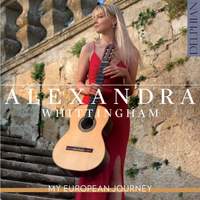Interview,
Alexandra Whittingham on My European Journey
 A decidedly modern artist, guitarist Alexandra Whittingham's combination of a busy live performance schedule with an extensive online presence exemplifies the kind of "dual-track" approach pursued by today's musicians. Educated in both jazz and classical guitar first at Chetham's School of Music in Manchester and then at the Royal Academy in London, she makes her recorded debut with a continent-trotting, pan-European collection of works from a variety of schools of guitar composition.
A decidedly modern artist, guitarist Alexandra Whittingham's combination of a busy live performance schedule with an extensive online presence exemplifies the kind of "dual-track" approach pursued by today's musicians. Educated in both jazz and classical guitar first at Chetham's School of Music in Manchester and then at the Royal Academy in London, she makes her recorded debut with a continent-trotting, pan-European collection of works from a variety of schools of guitar composition.
I spoke to Alexandra about the development of the instrument and its repertoire, particularly in the Romantic era on which the album focuses.
While you were at Chetham’s you were studying the piano as well as the guitar. When did you realise that you were destined to be a guitarist rather than a pianist?
I began learning the piano around three years into my studies at Chetham’s. Every student had to have a second instrument, and when I auditioned I’d just started learning the violin. I soon discovered that I wasn’t destined to be a violinist; I found it super difficult and a lot of my friends were amazing string players which made me sound even worse! I decided to take up the piano as a second study instead, and made much more progress on this as it seemed to come more naturally to me. That said, I think the guitar has always been the instrument I was meant to play!
The notes to this album open by referring to technical innovations in guitar-making in the 1800s. It mirrors similar developments in the history of the piano – do you think the impact on guitar performance and composition was comparable in terms of opening up new possibilities?
Absolutely! This was a time when music was reaching out to new, mass audiences, and a lot of these changes were really about enabling the guitar to project – to be both intimate and exciting, to be capable of a great range of expression and to communicate that to larger audiences in larger concert halls.
It also seems that some elements of virtuoso violin technique were adopted (and adapted) by composers of around the same time – how perceptible is this influence to you as a performer?
You can certainly hear these influences in Legnani’s music. His Fantasia for instance has countless virtuosic single-line passages, which resemble the violin writing of composers such as Paganini (who was a big inspiration for Legnani). Even within the Fantasia itself, there is so much contrast between the densely-textured sections and the sparse, intimate single lines that it gives the performer a great deal of freedom to express themselves in different ways.
Although Legnani and Regondi set out to become the equals of Paganini, Chopin and other such performer-composer stars, their names are rather less well-known today. What do you think went “wrong” in their cases, compared to their violinist and pianist counterparts?
The guitar has always been a little bit separate from orchestral and keyboard instruments. Many of the great composers didn’t write for guitar, and so you do find these other composers who specialised in the instrument – and were often players themselves. It’s true that their music has fallen from view in many cases, but that’s really what made it so exciting for me to rediscover them and to put together the programme for My European Journey. And as you say, they really were setting out to be virtuosos in the same way as the great violinists and pianists of the day, so there’s plenty of challenges and plenty of rewards in their music. Legnani’s Fantasia brillante e facile (which despite its title is far from ‘easy’!) and Regondi’s Introduction et Caprice are terrifically exciting both to listen to and to play.
Although the six-string guitar must have become fairly standard by his time, Johann Kaspar Mertz remained loyal to the ten-string form of the instrument in his compositions. Do works such as his Elegie pose particular challenges when you come to perform them on a six-string guitar?
In most instances, when the bass goes below the lowest note of the 6-string guitar (an E), playing this an octave higher is an effective solution which is adopted in modern editions. However, the depth of sound and timbre that the extra four strings provide is something that is difficult to come close to on the six-string guitar. I’d say the main challenge is maintaining a full sound in the chordal passages and accompaniment, whilst allowing the melody to sing on the top. The guitars that Mertz would have played were extremely different to those played today and were less consistent in their balance between each string, typically allowing the treble strings to project over basses. This is something that requires slightly more control and technical effort on modern guitars.
Although the repertoire on this album comes from all around Europe, the guitar is overwhelmingly associated with the south of the continent – why do you think it struggled to penetrate into the rest of Europe to the same extent?
Composers and artists were so fascinated by Spain in particular in this period – you only have to think of Bizet’s Carmen, or later, Debussy’s and Ravel’s Spanish-themed works. With its vibrant and rhythmic qualities, and its association with flamenco, the guitar tapped into the same obsession. But it’s also related to Arabic instruments like the oud, or even the ancient Greek kithara ... It’s really an instrument that can strongly evoke a variety of places and cultures, and that’s what I wanted to do here – by including pieces that range from Tárrega’s Capricho árabe to the Danish Frederik Rung’s Humoreske and pieces written in England by Catharina Josepha Pratten and Ernest Shand.
Having made your debut with this whistle-stop tour of Europe, can you tell us anything about your future recording plans?
There are so many areas of music I can’t wait to explore. The idea of bringing the guitar to a wider audience excites me a lot, so I’d like to do more arranging as there’s so much out there that would fit the instrument so well. Recording-wise, I’d love to record a disc of South-American music at some point. When I feel ready and I’ve done more touring I’d also really like to record a concerto disc!
Alexandra Whittingham (guitar)
Available Formats: CD, MP3, FLAC, Hi-Res FLAC



